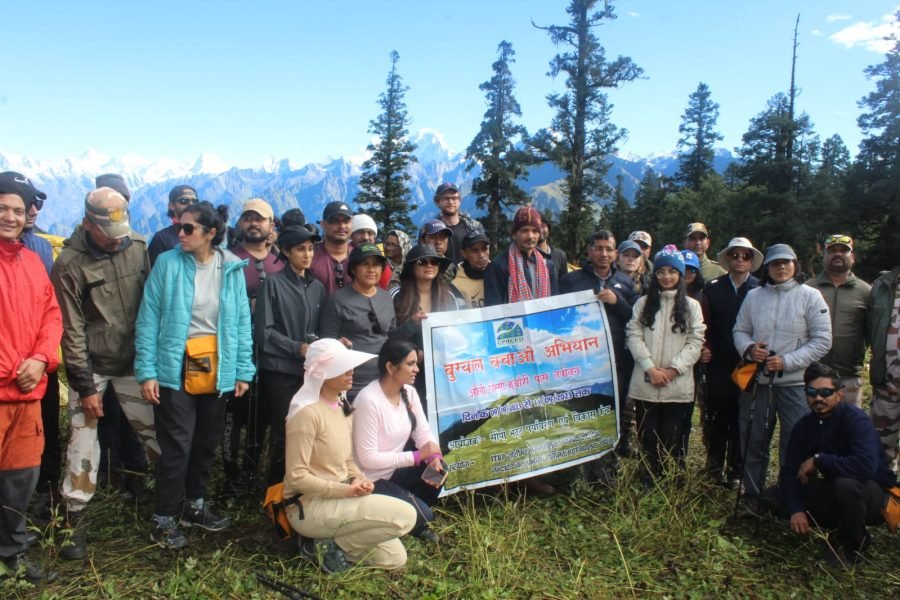The ambitious mission to safeguard the breathtaking Bugyals, known as alpine meadows, as invaluable treasures of natural beauty and biodiversity, reached its triumphant conclusion this Tuesday in Save Bugyals Campaign Succesfuly Concluded in Chamoli.
Launching in the lofty Himalayan realms within the Nanda Devi Biosphere Reserve on Saturday, the Bugyals Conservation Campaign wrapped up its endeavors near the Regadi village, nestled close to the Joshimath region.
Undeterred by heavy rains, the campaign expedition covered several kilometers on foot through the challenging terrain of the high Himalayas.
Renowned environmentalist Chandi Prasad Bhatt extended his heartfelt appreciation for the unwavering commitment of the campaign team, even in the face of adverse conditions. Drawing parallels with the historic Chipko Movement, which had its genesis in the Regadi village back in late 1973, Bhatt emphasized the importance of their work. It was in this very village that discussions and initiatives began, leading to the formation of Chipko committees across various villages dedicated to forest preservation.
He conveyed his gratitude to the Indo-Tibetan Border Police (ITBP), the Forest Department, and all team members for their pivotal roles in raising awareness.
Throughout the campaign, the team conducted a comprehensive study of over a dozen Bugyals, stretching between Auli and Kuwari Pass. They also symbolically removed non-biodegradable waste from the Bugyal and the adjacent forest areas.
The campaign witnessed active participation from local officials of the Indo-Tibetan Border Police, journalists, social workers, lawyers, university professors, and students. Gaurav Kumar, the Sub-Divisional Magistrate (SDM) of Nanda Devi National Park Division, and the Forest Division Officer played an active role.
The Bugyals Conservation Campaign kicked off with a discussion on the significance of preserving Bugyals at the Nagar Palika Parishad hall in Joshimath. The campaign’s first vehicle was flagged off at the ITBP grounds.
Leading the campaign, Samir Sinha, Chief Conservator of Forests, Uttarakhand, emphasized the pivotal role of Bugyals in the Himalayan ecosystem. He shed light on the ongoing efforts by the Forest Department for Bugyal conservation and the challenges posed by unsustainable nomadic herding practices.
ITBP Inspector Narendra Singh Negi addressed the team, providing insights into the environmental conservation efforts led by the Indo-Tibetan Border Police. During the campaign, SDM of Nanda Devi National Park Division, SDM Shishupal Singh Rawat, and Forest Range Officer Gaurav Negi shared information about the ongoing efforts to remove non-biodegradable waste from the Bugyals and the surrounding areas.
The Bugyals Conservation Campaign was initiated with a public discussion on Bugyal conservation, organized by the Department of History at Government P.G. College, Gopeshwar, under the leadership of Dr. H.C.S. Rawat, Head of the History Department.
The participants included Rakesh Parmar, a journalist from Delhi; Engineer Gaurav Bhasin from Delhi; Special Public Prosecutor Rakesh Mohan Pant from Chamoli District Court; Vinay Semwal; Gangasingh Saumya Bhatt; Nanda Devi Forest Division Officers Shishupal Singh Rawat and Range Officer Gaurav Negi, along with Inspector Narendra Singh Negi from the Indo-Tibetan Border Police.
Vinay Semwal and Omprakash Bhatt also joined the campaign team during its course.
The Bugyals Conservation Campaign was organized by the Centre for Environment and Development in Joshimath, with the invaluable support of the Nanda Devi National Park Forest Division and the Indo-Tibetan Border Police.
This campaign has been an annual tradition for the past decade since its inception, following the Nanda Devi Raj Jat Yatra in 2014. Each year, the campaign strives to raise awareness about the deteriorating conditions of the Bugyals and the urgent need for their preservation.
In its inaugural visit, the campaign team found these Bugyal areas relatively free from non-biodegradable waste. These meadows were previously strictly off-limits for grazing, based on religious beliefs.
However, over the past decade, there has been an increase in the population of stray cattle and horses, significantly impacting the local ecology. Several smaller areas also reported the presence of large groups of nomadic herders.
The pressure from these nomadic herders, especially Oli and Gaurasoun, has been most pronounced and has had the greatest impact on these areas. The herds leave a significant amount of waste behind during their brief stay, resulting in detrimental effects on the fragile Bugyal ecosystem.
The grazing pressure also hampers the regeneration of Bugyals. Conversations with herders revealed that after being allowed into the Bugyals, the yield from these meadows has significantly diminished.
Areas from which the campaign team set off have witnessed the adverse effects of unregulated Yarsagumba (a medicinal fungus) collection in recent years.
Sheepherders from different regions flock to these small areas during April and May, leaving their villages for a few months. This sudden influx of people exerts immense pressure on the environment, affecting not only the Bugyals but also the wildlife


